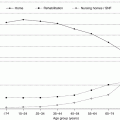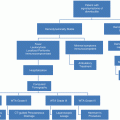Jay A. Yelon and Fred A. Luchette (eds.)Geriatric Trauma and Critical Care201410.1007/978-1-4614-8501-8_16
© Springer Science+Business Media New York 2014
16. Acute Abdomen
(1)
Department of Surgery, Stanford Hospital and Clinic, 300 Pasteur Drive, S-067, Stanford, CA 94305, USA
(2)
Department of Surgery, Stanford University Medical Center, 300 Pasteur Drive, S-067, Stanford, CA 94305-5655, USA
Abstract
Abdominal pain is a common complaint for geriatric patients presenting for emergency care. Older patients with acute abdominal pain tend to have a higher burden of intra-abdominal disease that is more difficult to diagnose, more frequently requires intervention, and results in worse outcomes than in younger patients. A complete history, careful physical exam, and judicious use of abdominal imaging are mandatory to improve diagnostic accuracy and optimize outcomes.
Acute Abdomen
Abdominal pain is one of the most common chief complaints for patients presenting for emergency medical care, regardless of age [1]. Older patients tend to present to medical attention in a more delayed fashion. For appendicitis and other intra-abdominal infections, the average duration of symptoms prior to presentation is 1–5 days longer in elderly patients compared to younger patients [2, 3].
Perhaps because of the tendency toward later presentation and the presence of comorbidities, older patients tend to have higher acuity of disease compared to younger patients with similar complaints and diagnoses. Forty to sixty percent of geriatric patients with acute abdominal pain require hospital admission, 10–30 % will require an operation or invasive procedure, and ultimately, the mortality rate is 5–8 %. The rates of admission and invasive intervention are roughly twice as high as those for younger patients with similar presentations, and the mortality rate is as much as five- or tenfold higher [4–7]. Accurately determining the diagnosis and the need for an operation in a timely fashion is both important and challenging in this patient population.
History and Physical Exam
A careful and complete history is fundamental to the evaluation of the acute abdomen. Unfortunately, geriatric patients presenting with acute abdominal symptoms often have nonspecific abdominal pain, leading to diagnostic inaccuracy which increases with age [6, 7]. Memory loss, with or without dementia, affects 3–8 % of the elderly population, which can present a significant obstacle to obtaining an accurate history [8, 9]. Furthermore, 25–45 % of elderly patient have significant hearing loss that can impair speech recognition in noisy settings such as the emergency department [10].
The presence of a family member, caretaker, or close friend can be invaluable in providing the history, clarifying the timeline or sequence of events, and to establish the patient’s baseline level of function prior to the onset of acute illness.
Open-ended questions often provide a more accurate story than closed-ended questions, which tends to confirm the preconceived notions of the medical team. The time course, location, quality, and radiation of pain should be established, along with any inciting or exacerbating factors such as positioning, movement, or coughing. Changes in the location or intensity of pain are important clues.
Associated symptoms including fevers, chills, nausea, vomiting, or changes in bowel or bladder habits should be elicited. The onset and quality of the vomitus may indicate the level of obstruction, be it distal or proximal. The frequency, consistency, and color of bowel movements may indicate obstruction, inflammation, or bleeding.
The majority of elderly patients have at least one comorbid condition that complicates their acute abdominal pain, and a careful review of cardiac and respiratory symptoms may help to identify important nonsurgical causes of acute abdominal pain such as pneumonia or myocardial infarction [3, 11]. Urinary symptoms should also be elicited, and postmenopausal bleeding is always significant and concerning for malignancy.
Previous operations and their indications should be well documented. Medications should be reviewed, paying particular attention to anticoagulants, antihypertensives, NSAIDs, steroids, antimicrobials, and immunosuppressants. The majority of elderly patients are taking at least one long-term medication, and the addition of a new medication has the potential to cause adverse drug reactions. Many of these reactions are gastrointestinal in nature and can mimic acute intra-abdominal pathology [12, 13]. Age-appropriate cancer screening study results should be reviewed.
Important aspects of the physical exam can be obtained, while the history is taken. The overall appearance of the patient, whether ill-appearing or obvious distressed, is crucial. Observations about the patient’s dress, grooming, or hygiene can be proxies for overall care access to medical attention and elder abuse. The patient’s habitus and the presence of cachexia are important indicators of nutrition and the ability to withstand a surgical intervention. The quality and rate of the pulse, skin turgor, and capillary refill time can provide important clues about systemic toxicity and overall volume status. The presence of fever is important, as many elderly patients with an acute surgical disease do mount a febrile response [14].
One major contributor to difficulties in diagnosis is the high prevalence of cognitive impairment present in this patient population. Although definitions of cognitive impairment vary, 17–20 % of elderly patients have some impairment in language, visuospatial awareness, or attention that can impair the examiner’s ability to elicit physical examination findings [9, 15]. Nonverbal signs of pain or tenderness such as wincing, grimacing, changes in breathing patterns, or tensing of the abdominal wall musculature take on a greater importance for patients who may not be able to communicate directly.
The sclera should be inspected for jaundice, and detection of conjunctival pallor can be a rapid way to screen for profound anemia. The mucous membranes of the face should be inspected for color and moisture. Neck masses and lymphadenopathy are important findings that can be associated with infection or malignancy.
The lung fields should be auscultated carefully to find signs of pneumonia or pleural effusions that sometimes mimic or accompany intra-abdominal pathology. The heart sounds should be auscultated carefully, as pericarditis and heart failure can both be present with abdominal pain. The flanks should be palpated and percussed for costovertebral angle tenderness as a sign of nephrolithiasis or upper urinary tract infection.
The abdomen is best examined from the patient’s right side, with the patient in the supine position and arms down at the sides. Having the patient flex both knees may allow for better relaxation of the abdominal wall and less guarding. The abdomen is inspected for distention and any obvious lesions or hernias. The stigmata of liver disease such as jaundice, spider angiomas, and caput medusae should be noted. The auscultation of high-pitched bowel sounds can occasionally be helpful in cases of suspected bowel obstruction.
When examining a tender abdomen, the goal is to elicit sufficient information without causing undue pain or discomfort. Asking the patient to cough prior to palpation may cause localized abdominal tenderness as a sign of peritoneal irritation. All four quadrants should be palpated, beginning in a quadrant away from the site of pain, and starting with gentle palpation and moving to deeper palpation as tolerated by the patient. Exquisite tenderness to percussion or light palpation signifies peritonitis, which does not need to be verified by deeper palpation. Assessing rebound in a patient when localized or generalized peritonitis has already been established is unnecessary, and only serves to distract the patient, thereby decreasing the sensitivity of other aspects of physical examination. Voluntary guarding, involuntary guarding, and “washboard” rigidity signify increasing degrees of visceral and parietal peritonitis. Obvious masses should be noted. Dullness to percussion or a palpable fluid wave signifies ascites that may be associated with liver disease, heart disease, malnutrition, or malignancy.
The digital rectal examination is a fundamental part of the evaluation and should not be omitted. The presence of rectal masses, tenderness, blood, and the presence and quality of stool in the rectal vault are all important clues.
In men, the genitalia and scrotum should be examined for hernias, torsion, and epididymitis. In women, a pelvic examination may be required to evaluate for adnexal masses, tenderness, or signs of a pelvic wall or floor hernia.
The pulse exam including palpation of extremity and abdominal pulsations is important to detect signs of vascular insufficiency and aneurysm related to mesenteric ischemia or abdominal aortic aneurysm disease as causes of acute abdominal pain. Peripheral edema can be a sign of venous occlusion or fluid overload.
Laboratory Analyses
Although laboratory analyses do not differentiate between surgical and nonsurgical causes of abdominal pain in elderly patients [16], routine evaluation should include a complete blood count, serum chemistries, liver function tests, serum amylase and/or lipase, and a urinalysis [16]. In general, most laboratory values in healthy elderly patients fall into the same reference ranges as younger patients [17–19].
The presence of leukocytosis can signify inflammation, infection, or malignancy. Hints to the chronicity and cause of anemia detected in the blood count can be found in the mean corpuscular volume, which may be microcytic in anemia of iron deficiency or chronic disease, or macrocytic in the setting of liver disease or malnutrition. Thrombocytopenia is a sensitive marker of portal hypertension.
Assessment of renal function including serum urea nitrogen (BUN) and serum creatinine is important for elderly patients with abdominal complaints. In addition to the azotemia from any fluid losses during acute illness, these patients may have underlying chronic kidney insufficiency. Furthermore, many patients with abdominal pain will undergo intravenous iodinated contrast injection for CT scanning, and an assessment of renal function is important to stratify risk for contrast nephropathy.
Measurement of electrolytes is important for patients who have had fluid losses from vomiting or diarrhea. Elderly patients taking diuretics also have a tendency to have electrolyte abnormalities even when healthy [19]. Glucose measurement may detect hypoglycemia from lack of oral intake and compounded by hypoglycemic therapy or hyperglycemia from diabetic ketoacidosis (DKA) or hyperosmolar non-ketotic coma (HONC) as causes of nonsurgical abdominal pain. Liver function tests are useful when liver or biliary disease is suspected. The measurement of serum amylase and/or lipase is mandatory if pancreatitis is a possibility.
Although elderly patients have a high incidence of malignancy, the measurement of serum tumor markers to screen for various cancers in patients with acute abdominal pain is costly, untimely, and unlikely to provide any useful information during the initial evaluation.
Diagnostic Imaging
Ideally, an imaging test is ordered to evaluate the diagnostic hypotheses generated by the history, physical exam, and laboratory analyses. Although advances in imaging technology continue to provide greater resolution, no radiographic test provides perfect diagnostic information for abdominal pain. Instead, the clinician’s must deal with probabilities and likelihoods, where the pretest probability of having a particular disease is modified by the likelihood ratio of the chosen imaging test result, which gives the posttest probability of having confirmed that particular diagnosis. Accordingly, the choice of imaging for each case depends on the performance of each imaging test to provide a high (or low) likelihood ratio in that particular situation.
Stay updated, free articles. Join our Telegram channel

Full access? Get Clinical Tree







